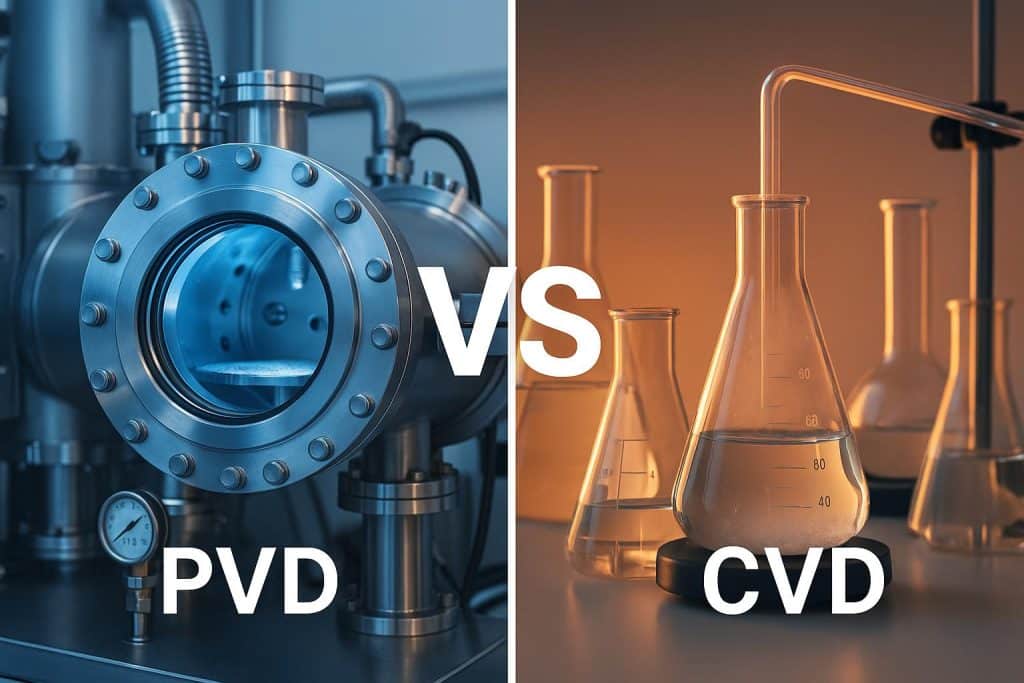Coatings are essential for improving material properties like wear resistance, corrosion resistance, and durability. Among the most widely used techniques are PVD (Physical Vapor Deposition) and CVD (Chemical Vapor Deposition). This article compares these two methods, exploring the difference between PVD and CVD coatings, to help you determine which is better for your specific needs.
Basic Principles of Operation
PVD (Physical Vapor Deposition)
PVD involves vaporizing a material in a vacuum environment, where it then condenses onto the substrate to form a thin, durable coating. This process is done at relatively low temperatures (50–450°C[a]), making it suitable for temperature-sensitive materials. Common PVD methods include evaporation, magnetron sputtering, and cathodic arc deposition.
Advantages of Physical Vapor Deposition:
- High-purity coatings with excellent adhesion.
- Environmentally friendly with minimal by-products.
- Ideal for temperature-sensitive materials.
Disadvantages of Physical Vapor Deposition:
- Limited to line-of-sight deposition, which means only accessible surfaces are coated.
- Coating thickness is typically limited to a few microns.
CVD (Chemical Vapor Deposition)
CVD is a chemical process in which gaseous precursors react on the substrate surface to form a solid coating. This method requires higher temperatures (600–1000°C), making it unsuitable for temperature-sensitive materials. Common techniques include Low Pressure CVD (LPCVD), Atmospheric Pressure CVD (APCVD), and Plasma Enhanced CVD (PECVD).
Advantages of Chemical Vapor Deposition:
- Provides uniform coating on complex geometries, including internal surfaces.
- Produces dense, strong coatings with excellent hardness and wear resistance.
- Can create thicker coatings (up to 75 microns).
Disadvantages of Chemical Vapor Deposition:
- High process temperatures, which may damage heat-sensitive materials.
- The process can produce toxic by-products, requiring additional precautions.
- The equipment for CVD is more complex and expensive.
Applications in Various Industries
Both PVD and CVD are used in a wide range of industries, each suited for specific applications:
- Automotive: PVD is ideal for parts exposed to wear (e.g., valves, pistons), while CVD is used for tools exposed to high temperatures (e.g., cutting tools).
- Medical Devices: PVD coatings offer biocompatibility for implants and surgical tools, while CVD is used for biocompatible coatings on joint replacements.
- Electronics: PVD is used for applying conductive layers, and CVD is used for insulating layers in semiconductor manufacturing.
- Tool Manufacturing: PVD is preferred for cutting tools, while CVD is used for hard coatings on tools that operate under high-temperature conditions.
I-Photonics offers advanced coating solutions and technologies that cater to various industrial needs, making it a valuable resource for industries looking to enhance their materials. For more information on coating technologies, check out I-Photonics.
Choosing the Right Method
The choice between PVD and CVD depends on several factors related to your material and application:
- Material Temperature Sensitivity: If your material is heat-sensitive, PVD is the better option as it operates at lower temperatures.
- Complex Part Geometry: For parts with complex or internal surfaces, CVD is preferable because it can uniformly coat intricate geometries.
- Coating Thickness: CVD is better suited for applications requiring thicker coatings, up to 75 microns, compared to the thinner coatings typically achieved with PVD.
- Environmental and Economic Considerations: PVD is more environmentally friendly but can be costlier due to more sophisticated equipment. CVD, while more cost-effective, may require extra measures to handle toxic by-products.
In summary, PVD vs CVD advantages and disadvantages come down to several factors: PVD is ideal for thin, high-purity coatings on temperature-sensitive materials, while CVD vs PVD coating is better for thicker, durable coatings on complex shapes and high-temperature applications. By understanding the requirements of your specific application—such as coating thickness, material properties, and environmental considerations—you can make an informed decision on the best coating method.
